warning light YAMAHA WR 450F 2012 Owners Manual
[x] Cancel search | Manufacturer: YAMAHA, Model Year: 2012, Model line: WR 450F, Model: YAMAHA WR 450F 2012Pages: 96, PDF Size: 2.47 MB
Page 6 of 96

TABLE OF CONTENTSSAFETY INFORMATION .................. 1-1
DESCRIPTION .................................. 2-1
Left view .......................................... 2-1
Right view ........................................ 2-2
Controls and instrument s................. 2-3
INSTRUMENT AND CONTROL
FUNCTIONS ....................................... 3-1
Main switch ..................................... 3-1
Indicator lights and warning
lights ............................................ 3-1
Multi-function display ...................... 3-2
Handlebar switches ........................ 3-7
Clutch lever ..................................... 3-8
Shift pedal ...... ............................. .... 3-8
Brake lever ..................................... 3-8
Brake pedal .................................... 3-9
Fuel tank cap .................................. 3-9
Fuel ............................................... 3-10
Fuel tank breather hose ................ 3-11
Catalytic converter ........................ 3-11
Starter knob .................................. 3-12
Kickstarter ...... ............................. .. 3-12
Steering lock ................................. 3-13
Seat .............................................. 3-13
Adjusting the front fork .................. 3-14
Front fork bleeding ........................ 3-15
Adjusting the shock absorber assembly ................................... 3-16
Sidestand ...................................... 3-18 Ignition circuit cut-o
ff system ........ 3-19
FOR YOUR SAFETY –
PRE-OPERATION CHECKS ............. 4-1
OPERATION AND IMPORTANT
RIDING POINTS ................................. 5-1
Starting a cold engine .................... 5-1
Starting a warm engine .................. 5-2
Shifting ........................................... 5-3
Tips for reducing fuel
consumption ............................... 5-3
Engine break-in .............................. 5-4
Parking ........................................... 5-5
PERIODIC MAINTENANCE AND
ADJUSTMENT ................................... 6-1
Owner’s tool kit ............................... 6-2
Periodic maintenance chart for the emission control system ............. 6-3
General maintenance and lubrication chart .......................... 6-4
Removing and installing the
panel ........................................... 6-7
Checking the spark plug ................. 6-7
Engine oil and oil filter element ...... 6-8
Coolant ......................................... 6-12
Cleaning the air filter element
and check hose ......................... 6-14
Adjusting the engine idling speed ........................................ 6-17 Checking the throttle grip free
play ............................................ 6-17
Valve clearance ............................ 6-18
Tires .............................................. 6-18
Spoke wheels ............................... 6-20
Adjusting the clutch lever free play ............................................ 6-20
Checking the brake lever free
play ............................................ 6-21
Checking the shift pedal ............... 6-22
Brake light switches ...................... 6-22
Checking the front and rear brake pads ................................. 6-22
Checking the brake fluid level ....... 6-23
Changing the brake fluid ............... 6-24
Drive chain slack ........................... 6-24
Cleaning and lubricating the
drive chain ................................. 6-26
Checking and lubricating the cables ........................................ 6-26
Checking and lubricating the throttle grip and cable ................ 6-27
Checking and lubricating the
brake and clutch levers ............. 6-27
Checking and lubricating the
brake pedal ................................ 6-28
Checking and lubricating the sidestand ................................... 6-28
Lubricating the swingarm pivots ... 6-28
Checking the front fork .................. 6-29
Checking the steering ................... 6-291DX-9-E0.book 1 ページ 2011年10月10日 月曜日 午後2時14分
Page 16 of 96
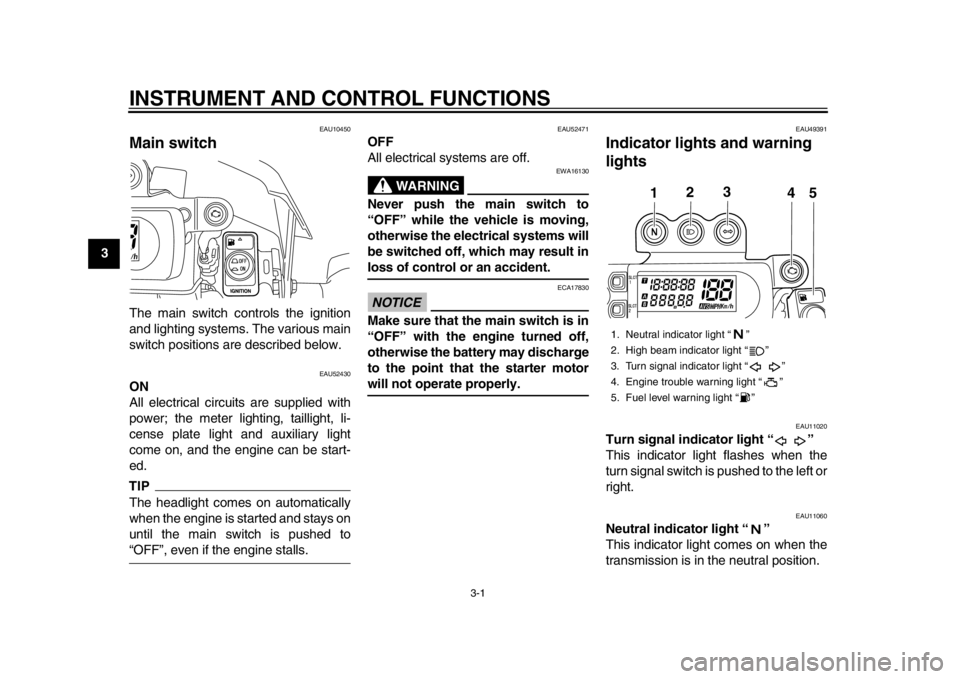
3-1
1
23
4
5
6
7
8
9
INSTRUMENT AND CONTROL FUNCTIONS
EAU10450
Main switch The main switch controls the ignition
and lighting systems. The various main
switch positions are described below.
EAU52430
ON
All electrical circuits are supplied with
power; the meter lighting, taillight, li-
cense plate light and auxiliary light
come on, and the engine can be start-
ed. TIPThe headlight comes on automatically
when the engine is started and stays on
until the main switch is pushed to“OFF”, even if the engine stalls.
EAU52471
OFF
All electrical systems are off.
WARNING
EWA16130
Never push the main switch to
“OFF” while the vehicle is moving,
otherwise the electrical systems will
be switched off, which may result inloss of control or an accident.NOTICE
ECA17830
Make sure that the main switch is in
“OFF” with the engine turned off,
otherwise the battery may discharge
to the point that the starter motorwill not operate properly.
EAU49391
Indicator lights and warning
lights
EAU11020
Turn signal indicator light “ ”
This indicator light flashes when the
turn signal switch is pushed to the left or
right.
EAU11060
Neutral indicator light “ ”
This indicator light comes on when the
transmission is in the neutral position.1. Neutral indicator light “ ”
2. High beam indicator light “ ”
3. Turn signal indicator light “ ”
4. Engine trouble warning light “ ”
5. Fuel level warning light “ ”
1
2
3
4
5
1DX-9-E0.book 1 ページ 2011年10月10日 月曜日 午後2時14分
Page 17 of 96
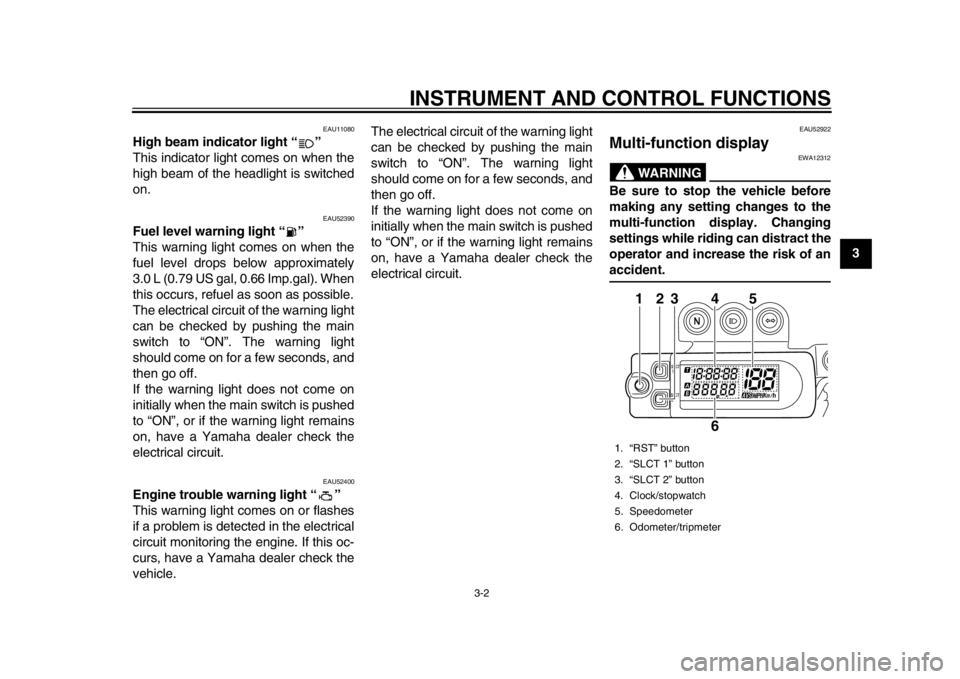
INSTRUMENT AND CONTROL FUNCTIONS
3-2
234
5
6
7
8
9
EAU11080
High beam indicator light “ ”
This indicator light comes on when the
high beam of the headlight is switched
on.
EAU52390
Fuel level warning light “ ”
This warning light comes on when the
fuel level drops below approximately
3.0 L (0.79 US gal, 0.66 Imp.gal). When
this occurs, refuel as soon as possible.
The electrical circuit of the warning light
can be checked by pushing the main
switch to “ON”. The warning light
should come on for a few seconds, and
then go off.
If the warning light does not come on
initially when the main switch is pushed
to “ON”, or if the warning light remains
on, have a Yamaha dealer check the
electrical circuit.
EAU52400
Engine trouble warning light “ ”
This warning light comes on or flashes
if a problem is detected in the electrical
circuit monitoring the engine. If this oc-
curs, have a Yamaha dealer check the
vehicle. The electrical circuit of the warning light
can be checked by pushing the main
switch to “ON”. The warning light
should come on for a few seconds, and
then go off.
If the warning light does not come on
initially when the main switch is pushed
to “ON”, or if the warning light remains
on, have a Yamaha dealer check the
electrical circuit.
EAU52922
Multi-function display
WARNING
EWA12312
Be sure to stop the vehicle before
making any setting changes to the
multi-function display. Changing
settings while riding can distract the
operator and increase the risk of anaccident.1. “RST” button
2. “SLCT 1” button
3. “SLCT 2” button
4. Clock/stopwatch
5. Speedometer
6. Odometer/tripmeter
123
4
6
5
1DX-9-E0.book 2 ページ 2011年10月10日 月曜日 午後2時14分
Page 22 of 96
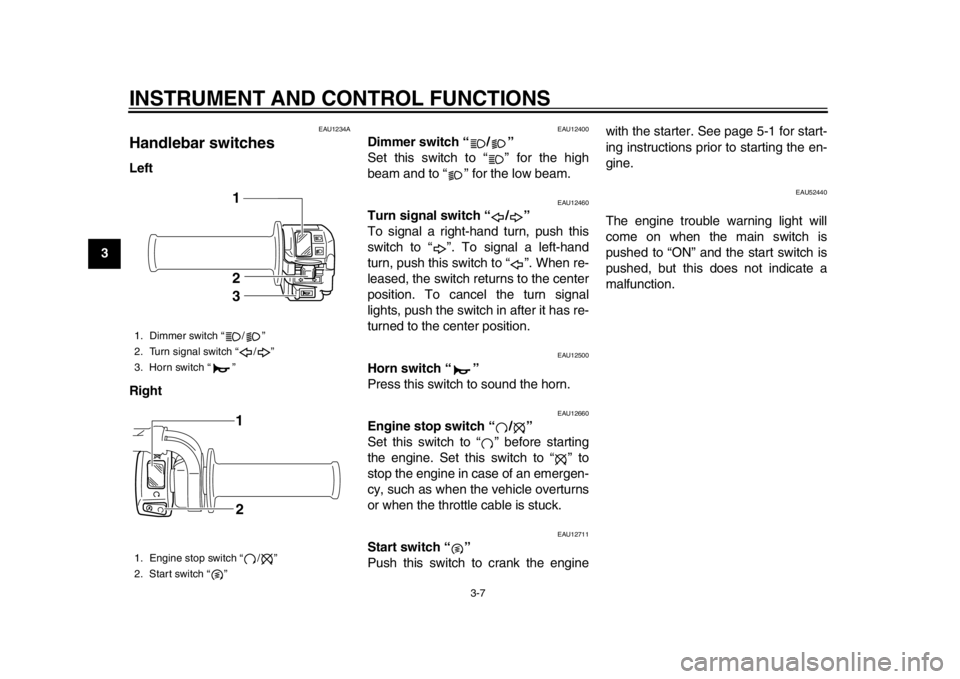
INSTRUMENT AND CONTROL FUNCTIONS
3-7
1
23
4
5
6
7
8
9
EAU1234A
Handlebar switches Left
Right
EAU12400
Dimmer switch “ / ”
Set this switch to “ ” for the high
beam and to “ ” for the low beam.
EAU12460
Turn signal switch “ / ”
To signal a right-hand turn, push this
switch to “ ”. To signal a left-hand
turn, push this switch to “ ”. When re-
leased, the switch returns to the center
position. To cancel the turn signal
lights, push the switch in after it has re-
turned to the center position.
EAU12500
Horn switch “ ”
Press this switch to sound the horn.
EAU12660
Engine stop switch “ / ”
Set this switch to “ ” before starting
the engine. Set this switch to “ ” to
stop the engine in case of an emergen-
cy, such as when the vehicle overturns
or when the throttle cable is stuck.
EAU12711
Start switch “ ”
Push this switch to crank the enginewith the starter. See page 5-1 for start-
ing instructions prior to starting the en-
gine.
EAU52440
The engine trouble warning light will
come on when the main switch is
pushed to “ON” and the start switch is
pushed, but this does not indicate a
malfunction.
1. Dimmer switch “ / ”
2. Turn signal switch “ / ”
3. Horn switch “ ”
1. Engine stop switch “ / ”
2. Start switch “ ”
1
2
31
2
1DX-9-E0.book 7 ページ 2011年10月10日 月曜日 午後2時14分
Page 25 of 96
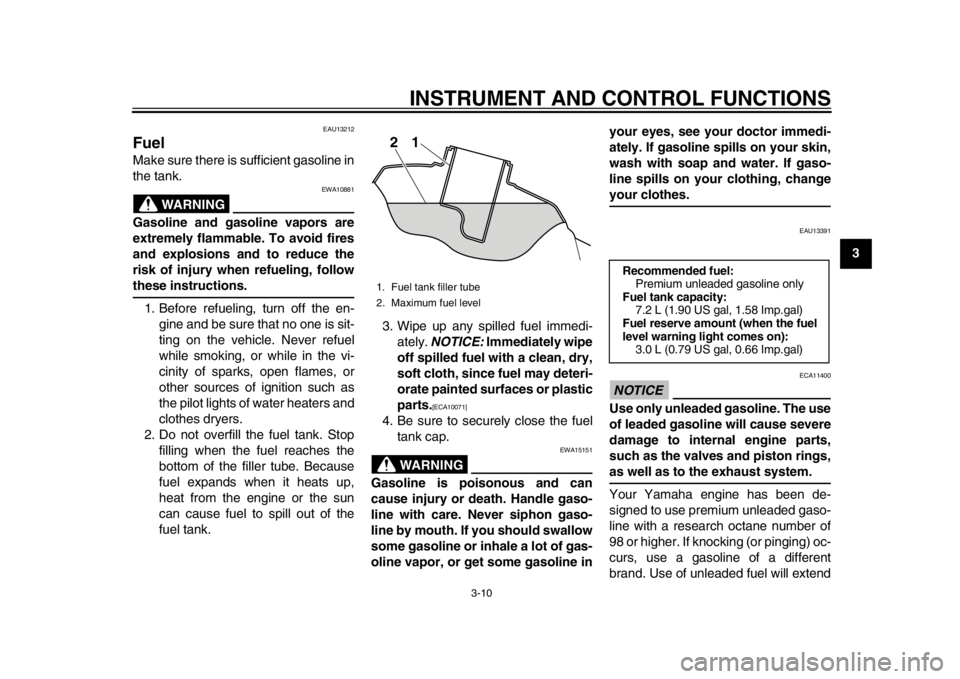
INSTRUMENT AND CONTROL FUNCTIONS
3-10
234
5
6
7
8
9
EAU13212
Fuel Make sure there is sufficient gasoline in
the tank.
WARNING
EWA10881
Gasoline and gasoline vapors are
extremely flammable. To avoid fires
and explosions and to reduce the
risk of injury when refueling, followthese instructions.1. Before refueling, turn off the en- gine and be sure that no one is sit-
ting on the vehicle. Never refuel
while smoking, or while in the vi-
cinity of sparks, open flames, or
other sources of ignition such as
the pilot lights of water heaters and
clothes dryers.
2. Do not overfill the fuel tank. Stop filling when the fuel reaches the
bottom of the filler tube. Because
fuel expands when it heats up,
heat from the engine or the sun
can cause fuel to spill out of the
fuel tank. 3. Wipe up any spilled fuel immedi-
ately. NOTICE: Immediately wipe
off spilled fuel with a clean, dry,
soft cloth, since fuel may deteri-
orate painted surfaces or plastic
parts.
[ECA10071]
4. Be sure to securely close the fuel tank cap.
WARNING
EWA15151
Gasoline is poisonous and can
cause injury or death. Handle gaso-
line with care. Never siphon gaso-
line by mouth. If you should swallow
some gasoline or inhale a lot of gas-
oline vapor, or get some gasoline in your eyes, see your doctor immedi-
ately. If gasoline spills on your skin,
wash with soap and water. If gaso-
line spills on your clothing, change
your clothes.
EAU13391
NOTICE
ECA11400
Use only unleaded gasoline. The use
of leaded gasoline will cause severe
damage to internal engine parts,
such as the valves and piston rings,as well as to the exhaust system.
Your Yamaha engine has been de-
signed to use premium unleaded gaso-
line with a research octane number of
98 or higher. If knocking (or pinging) oc-
curs, use a gasoline of a different
brand. Use of unleaded fuel will extend
1. Fuel tank filler tube
2. Maximum fuel level
21
Recommended fuel:
Premium unleaded gasoline only
Fuel tank capacity:
7.2 L (1.90 US gal, 1.58 Imp.gal)
Fuel reserve amount (when the fuel
level warning light comes on): 3.0 L (0.79 US gal, 0.66 Imp.gal)
1DX-9-E0.book 10 ページ 2011年10月10日 月曜日 午後2時14分
Page 39 of 96
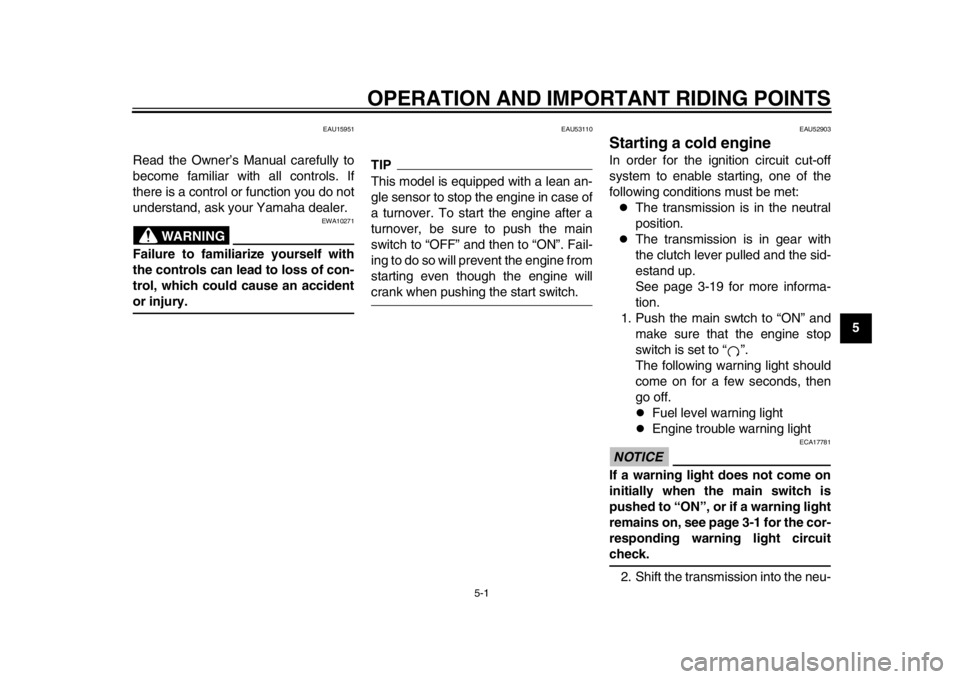
5-1
2
3
456
7
8
9
OPERATION AND IMPORTANT RIDING POINTS
EAU15951
Read the Owner’s Manual carefully to
become familiar with all controls. If
there is a control or function you do not
understand, ask your Yamaha dealer.
WARNING
EWA10271
Failure to familiarize yourself with
the controls can lead to loss of con-
trol, which could cause an accidentor injury.
EAU53110
TIPThis model is equipped with a lean an-
gle sensor to stop the engine in case of
a turnover. To start the engine after a
turnover, be sure to push the main
switch to “OFF” and then to “ON”. Fail-
ing to do so will prevent the engine from
starting even though the engine willcrank when pushing the start switch.
EAU52903
Starting a cold engine In order for the ignition circuit cut-off
system to enable starting, one of the
following conditions must be met:
The transmission is in the neutral
position.
The transmission is in gear with
the clutch lever pulled and the sid-
estand up.
See page 3-19 for more informa-
tion.
1. Push the main swtch to “ON” and make sure that the engine stop
switch is set to “ ”.
The following warning light should
come on for a few seconds, then
go off.
Fuel level warning light
Engine trouble warning light
NOTICE
ECA17781
If a warning light does not come on
initially when the main switch is
pushed to “ON”, or if a warning light
remains on, see page 3-1 for the cor-
responding warning light circuitcheck.
2. Shift the transmission into the neu-
1DX-9-E0.book 1 ページ 2011年10月10日 月曜日 午後2時14分
Page 51 of 96
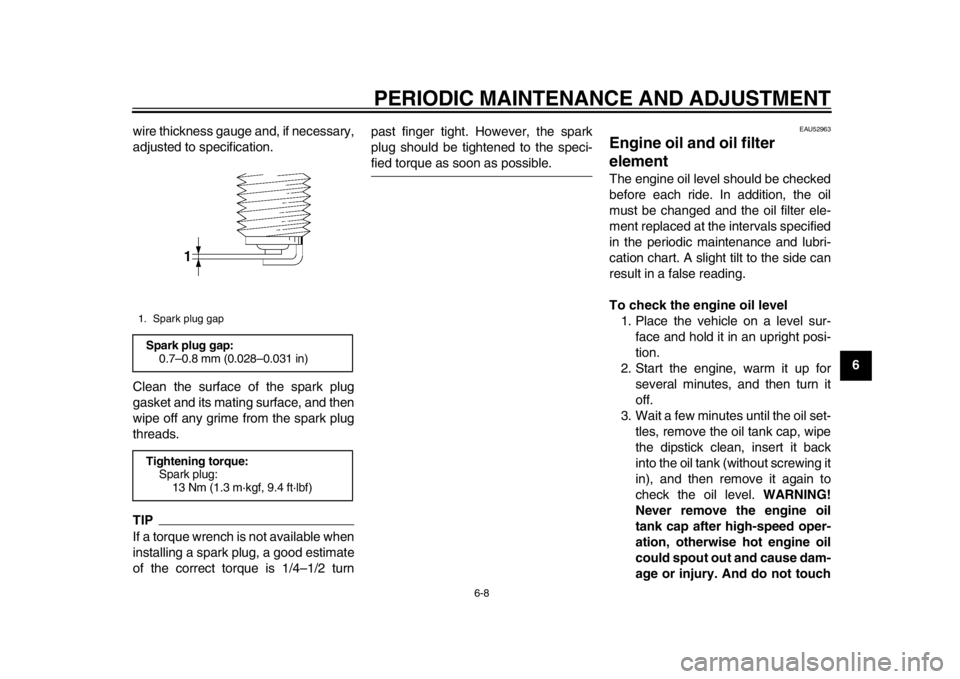
PERIODIC MAINTENANCE AND ADJUSTMENT
6-8
2
3
4
567
8
9
wire thickness gauge and, if necessary,
adjusted to specification.
Clean the surface of the spark plug
gasket and its mating surface, and then
wipe off any grime from the spark plug
threads.
TIPIf a torque wrench is not available when
installing a spark plug, a good estimate
of the correct torque is 1/4–1/2 turn past finger tight. However, the spark
plug should be tightened to the speci-
fied torque as soon as possible.
EAU52963
Engine oil and oil filter
element The engine oil level should be checked
before each ride. In addition, the oil
must be changed and the oil filter ele-
ment replaced at the intervals specified
in the periodic maintenance and lubri-
cation chart. A slight tilt to the side can
result in a false reading.
To check the engine oil level
1. Place the vehicle on a level sur- face and hold it in an upright posi-
tion.
2. Start the engine, warm it up for several minutes, and then turn it
off.
3. Wait a few minutes until the oil set- tles, remove the oil tank cap, wipe
the dipstick clean, insert it back
into the oil tank (without screwing it
in), and then remove it again to
check the oil level. WARNING!
Never remove the engine oil
tank cap after high-speed oper-
ation, otherwise hot engine oil
could spout out and cause dam-
age or injury. And do not touch
1. Spark plug gapSpark plug gap: 0.7–0.8 mm (0.028–0.031 in)
Tightening torque: Spark plug: 13 Nm (1.3 m·kgf, 9.4 ft·lbf)
1DX-9-E0.book 8 ページ 2011年10月10日 月曜日 午後2時14分
Page 55 of 96
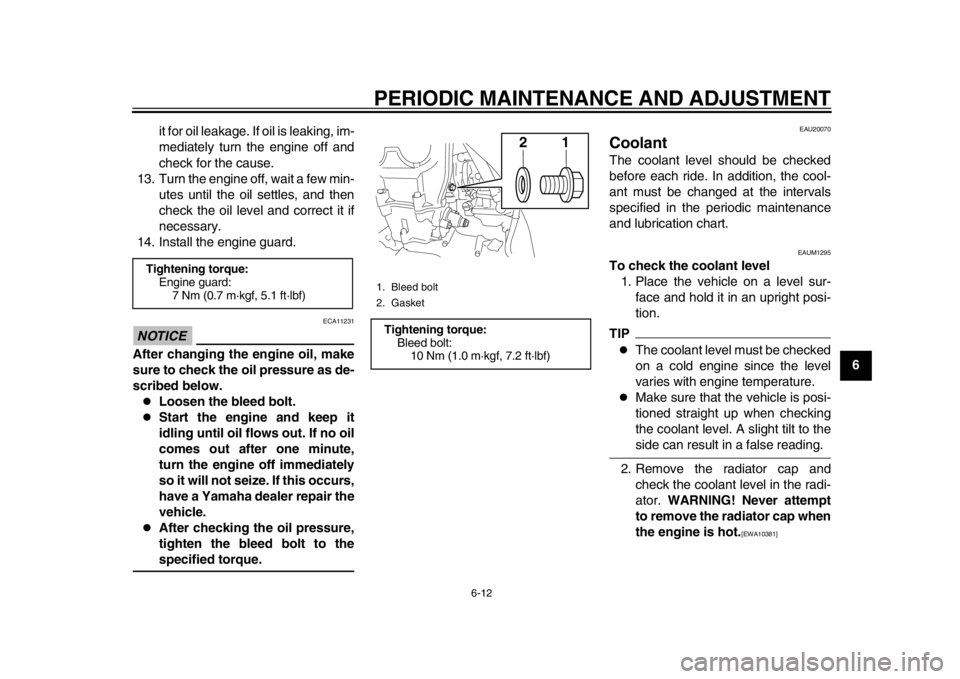
PERIODIC MAINTENANCE AND ADJUSTMENT
6-12
2
3
4
567
8
9
it for oil leakage. If oil is leaking, im-
mediately turn the engine off and
check for the cause.
13. Turn the engine off, wait a few min- utes until the oil settles, and then
check the oil level and correct it if
necessary.
14. Install the engine guard.
NOTICE
ECA11231
After changing the engine oil, make
sure to check the oil pressure as de-
scribed below.
Loosen the bleed bolt.
Start the engine and keep it
idling until oil flows out. If no oil
comes out after one minute,
turn the engine off immediately
so it will not seize. If this occurs,
have a Yamaha dealer repair the
vehicle.
After checking the oil pressure,
tighten the bleed bolt to thespecified torque.
EAU20070
Coolant The coolant level should be checked
before each ride. In addition, the cool-
ant must be changed at the intervals
specified in the periodic maintenance
and lubrication chart.
EAUM1295
To check the coolant level 1. Place the vehicle on a level sur- face and hold it in an upright posi-
tion.TIP
The coolant level must be checked
on a cold engine since the level
varies with engine temperature.
Make sure that the vehicle is posi-
tioned straight up when checking
the coolant level. A slight tilt to theside can result in a false reading.
2. Remove the radiator cap and check the coolant level in the radi-
ator. WARNING! Never attempt
to remove the radiator cap when
the engine is hot.
[EWA10381]
Tightening torque: Engine guard: 7 Nm (0.7 m·kgf, 5.1 ft·lbf)
1. Bleed bolt
2. GasketTightening torque:Bleed bolt:
10 Nm (1.0 m·kgf, 7.2 ft·lbf)
21
1DX-9-E0.book 12 ページ 2011年10月10日 月曜日 午後2時14分
Page 82 of 96
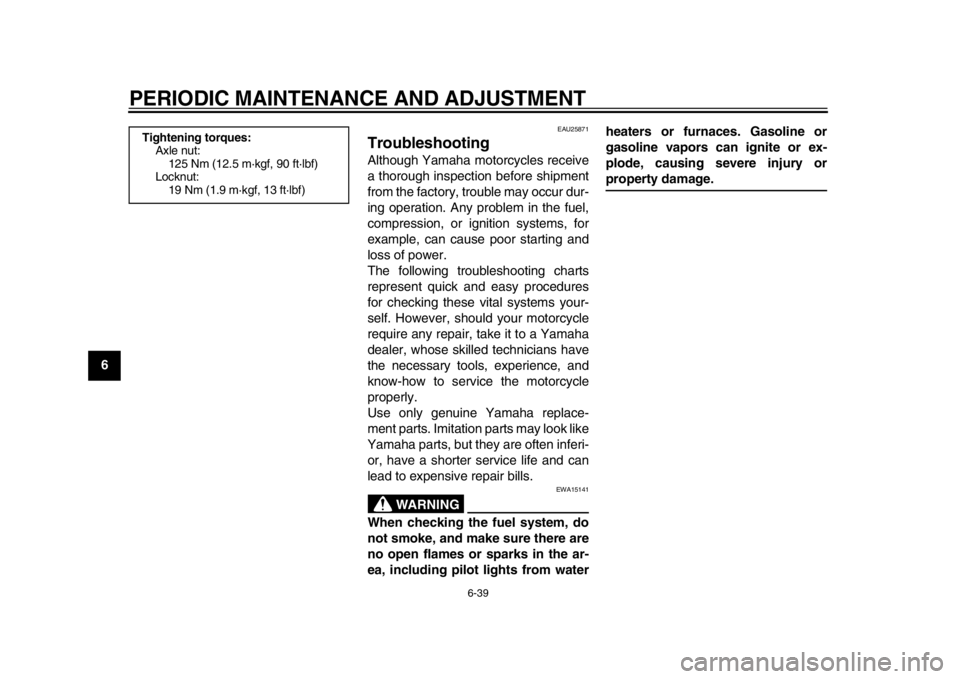
PERIODIC MAINTENANCE AND ADJUSTMENT
6-39
1
2
3
4
56
7
8
9
EAU25871
Troubleshooting Although Yamaha motorcycles receive
a thorough inspection before shipment
from the factory, trouble may occur dur-
ing operation. Any problem in the fuel,
compression, or ignition systems, for
example, can cause poor starting and
loss of power.
The following troubleshooting charts
represent quick and easy procedures
for checking these vital systems your-
self. However, should your motorcycle
require any repair, take it to a Yamaha
dealer, whose skilled technicians have
the necessary tools, experience, and
know-how to service the motorcycle
properly.
Use only genuine Yamaha replace-
ment parts. Imitation parts may look like
Yamaha parts, but they are often inferi-
or, have a shorter service life and can
lead to expensive repair bills.
WARNING
EWA15141
When checking the fuel system, do
not smoke, and make sure there are
no open flames or sparks in the ar-
ea, including pilot lights from waterheaters or furnaces. Gasoline or
gasoline vapors can ignite or ex-
plode, causing severe injury or
property damage.
Tightening torques:
Axle nut:125 Nm (12.5 m·kgf, 90 ft·lbf)
Locknut:
19 Nm (1.9 m·kgf, 13 ft·lbf)
1DX-9-E0.book 39 ページ 2011年10月10日 月曜日 午後2時14分
Page 87 of 96
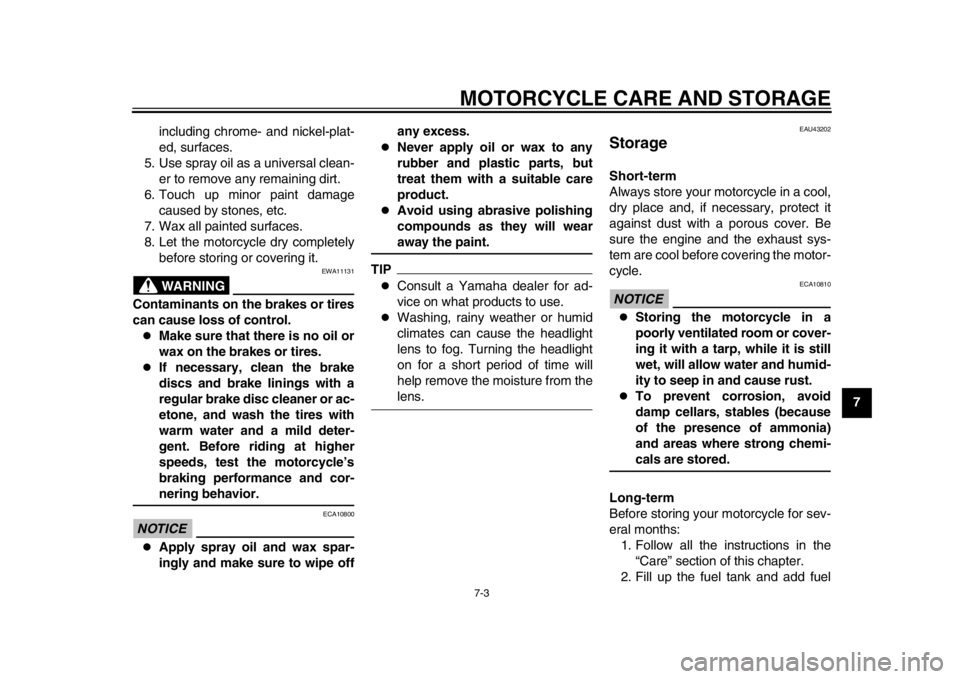
MOTORCYCLE CARE AND STORAGE
7-3
2
3
4
5
678
9
including chrome- and nickel-plat-
ed, surfaces.
5. Use spray oil as a universal clean- er to remove any remaining dirt.
6. Touch up minor paint damage caused by stones, etc.
7. Wax all painted surfaces.
8. Let the motorcycle dry completely before storing or covering it.
WARNING
EWA11131
Contaminants on the brakes or tires
can cause loss of control.
Make sure that there is no oil or
wax on the brakes or tires.
If necessary, clean the brake
discs and brake linings with a
regular brake disc cleaner or ac-
etone, and wash the tires with
warm water and a mild deter-
gent. Before riding at higher
speeds, test the motorcycle’s
braking performance and cor-nering behavior.
NOTICE
ECA10800
Apply spray oil and wax spar-
ingly and make sure to wipe off any excess.
Never apply oil or wax to any
rubber and plastic parts, but
treat them with a suitable care
product.
Avoid using abrasive polishing
compounds as they will wearaway the paint.
TIP
Consult a Yamaha dealer for ad-
vice on what products to use.
Washing, rainy weather or humid
climates can cause the headlight
lens to fog. Turning the headlight
on for a short period of time will
help remove the moisture from thelens.
EAU43202
Storage Short-term
Always store your motorcycle in a cool,
dry place and, if necessary, protect it
against dust with a porous cover. Be
sure the engine and the exhaust sys-
tem are cool before covering the motor-
cycle.NOTICE
ECA10810
Storing the motorcycle in a
poorly ventilated room or cover-
ing it with a tarp, while it is still
wet, will allow water and humid-
ity to seep in and cause rust.
To prevent corrosion, avoid
damp cellars, stables (because
of the presence of ammonia)
and areas where strong chemi-cals are stored.
Long-term
Before storing your motorcycle for sev-
eral months: 1. Follow all the instructions in the “Care” section of this chapter.
2. Fill up the fuel tank and add fuel
1DX-9-E0.book 3 ページ 2011年10月10日 月曜日 午後2時14分